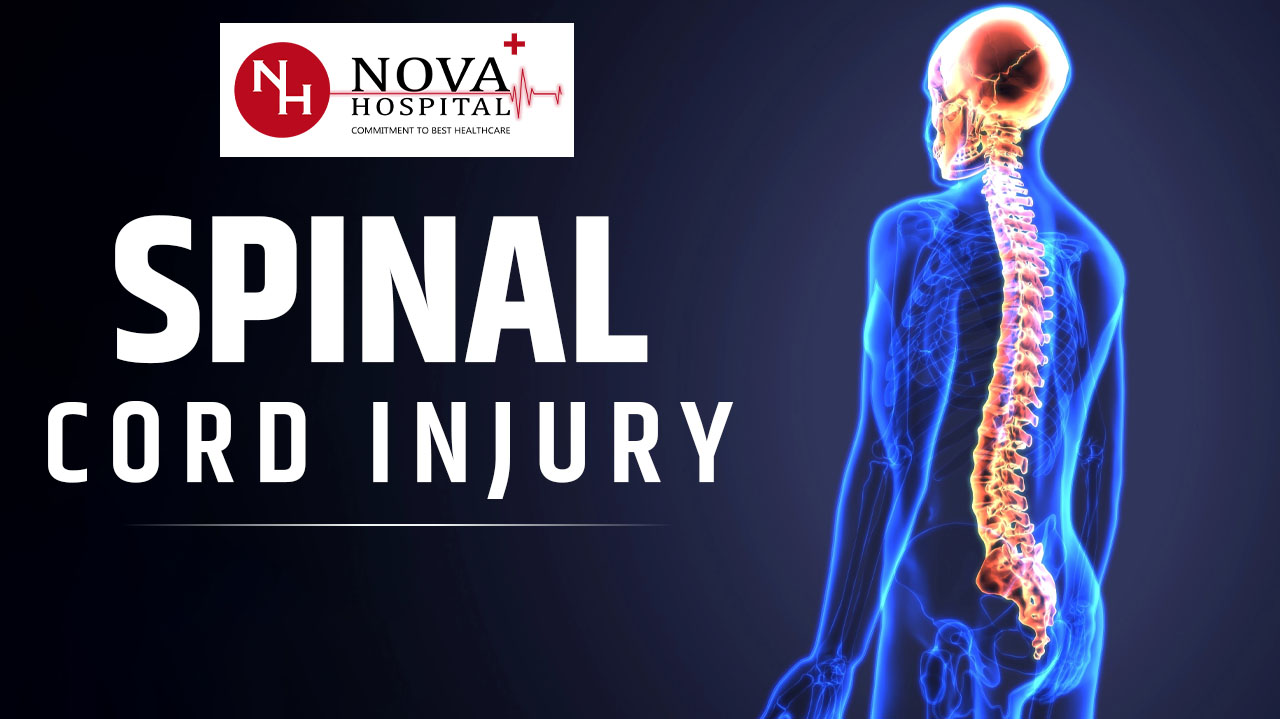Chronic Complications: Spinal Cord Injury
A spinal cord injury (SCI) occurs when there is damage to the spinal cord, which can result in a loss of function and mobility. The severity of an SCI can vary and can result in a range of symptoms from partial or complete paralysis to loss of sensation.
The spinal cord is a complex network of nerves that transmit signals between the brain and the rest of the body, and when it is damaged, these signals can be disrupted.
The most common causes of spinal cord injuries include traumatic events such as car accidents, falls, and sports injuries, while others can occur due to disease or congenital conditions.
Diagnosis of SCI typically involves a physical examination and imaging studies such as MRI or CT scan. Treatment options can include surgery, rehabilitation, and the use of adaptive equipment. The long-term prognosis for individuals with SCI can vary and may depend on the severity of the injury and the individual’s level of function before the injury.
Research into SCI is ongoing, and several promising developments in the fields of regenerative medicine and neuroprosthetics aim to improve recovery and function for individuals with SCI.
Types of spinal cord injuries (Complete vs. Incomplete)
Spinal cord injuries are classified as either complete or incomplete. Complete spinal cord injury: In this type of injury, there is a total loss of function and sensation below the level of the injury. This means that the person will have no movement or feeling in the affected area.
Incomplete spinal cord injury: In this type of injury, there is some preservation of function and sensation below the level of the injury. This means that the person will have some movement or feeling in the affected area.
The classification of the injury is based on the level of the injury, the type of injury, and the degree of the injury. The American Spinal Injury Association (ASIA) Impairment Scale is commonly used to classify the severity of an incomplete SCI. It ranges from A (no motor or sensory function) to E (normal motor and sensory function).
It is important to note that the distinction between complete and incomplete injuries is not always clear-cut, as some individuals may experience varying degrees of recovery over time.
Symptoms of Spinal Cord Injuries (Paralysis, Loss of Sensation, etc.)
The symptoms of a spinal cord injury (SCI) can vary depending on the location and severity of the injury. Some common symptoms include:
- Paralysis: Loss of muscle function and movement in the affected area. This can range from partial paralysis (also called “paresis”) to complete paralysis (also called “paraplegia” for injuries at the thoracic level and below, or “tetraplegia” for injuries at the cervical level).
- Loss of bowel and bladder control: Some people with SCI may experience difficulty controlling their bowel and bladder function.
- Chronic pain: Some people with SCI may experience chronic pain, especially in areas where there is a loss of sensation.
- Respiratory issues: SCI can also cause respiratory problems, especially if the injury is in the thoracic area, which affects the muscles responsible for breathing.
- Spasticity: Some people with SCI may experience spasticity or increased muscle tone, which can cause stiffness and difficulty moving.
- Autonomic dysreflexia: this is a potentially life-threatening condition, characterized by sudden high blood pressure and other autonomic nervous system changes that occur in people who have spinal cord injuries above T6.
The symptoms of a spinal cord injury may not appear immediately after the injury. Some symptoms may take hours or days to develop, and others may not appear until several weeks after the injury.
Diagnosis and Assessment of Spinal Cord Injuries (imaging, neurological exams, etc.)
Diagnosis and assessment of spinal cord injuries (SCI) typically involve a combination of imaging studies, physical examination, and neurological tests.
Imaging studies such as X-rays, CT scans, and MRI can help to identify any structural damage to the spine and spinal cord, including fractures, dislocations, or hematomas. These studies can also help to rule out other potential causes of symptoms, such as tumors or infections.
A physical examination will typically involve a thorough assessment of the individual’s motor and sensory function, reflexes, and overall level of consciousness. This can help to identify the specific location and severity of the injury, as well as any other related injuries.
Neurological tests can also be used to evaluate the individual’s motor and sensory function, reflexes, and overall level of consciousness. This can include simple tests such as pinprick and light touch sensation, as well as more complex tests such as the American Spinal Injury Association (ASIA) examination.
Once the injury has been diagnosed, the patient will typically be assessed by a multidisciplinary team of healthcare providers including a spinal cord injury specialist, physical therapist, occupational therapist, rehabilitation psychologist, and others to provide the best care and treatment plan.
It’s important to note that diagnosis and assessment of SCI can be challenging and may take time. In some cases, it may take several days or weeks for the full extent of the injury to become apparent.
Treatment Options for Spinal Cord Injuries (Surgery, Rehabilitation, etc.)
Treatment options for spinal cord injuries (SCI) can vary depending on the location and severity of the injury, as well as the individual’s overall health and medical history.
Some common treatment options include:
- Surgery: Surgery may be necessary to stabilize the spine and reduce the risk of further injury. This can include procedures such as spinal fusion, laminectomy, or decompression. Surgery may also be used to remove any hematomas or other masses that are putting pressure on the spinal cord.
- Rehabilitation: Rehabilitation is an important part of the recovery process for individuals with SCI. This can include physical therapy, occupational therapy, and speech therapy to help improve motor function, sensation, and overall independence.
- Medications: Medications can be used to manage symptoms such as pain, spasticity, and bladder and bowel dysfunction.
- Adaptive equipment: Individuals with SCI may require adaptive equipment to help them with daily activities. This can include things like wheelchairs, braces, and communication devices.
- Stem cell therapy: Stem cell therapy is an experimental treatment that aims to repair or replace damaged cells in the spinal cord, but it is not yet widely available, and more research is needed to determine its safety and efficacy.
- Neuroprosthetics: Some individuals with SCI may benefit from neuroprosthetic devices, such as functional electrical stimulation (FES) systems, which can be used to restore muscle function and movement in the affected area.
It’s important to note that recovery from SCI can be a long-term process, and treatment plans will typically be tailored to the individual’s specific needs and goals.
Long-Term Effects and Complications of Spinal Cord Injuries (Chronic Pain, Respiratory Issues, etc.)
Spinal cord injuries (SCI) can have a wide range of long-term effects and complications. These can vary depending on the location and severity of the injury, as well as the individual’s overall health and medical history.
Some common long-term effects and complications of SCI include:
- Chronic pain: Some people with SCI may experience chronic pain, especially in areas where there is a loss of sensation.
- Respiratory issues: SCI can also cause respiratory problems, especially if the injury is in the thoracic area, which affects the muscles responsible for breathing.
- Spasticity: Some people with SCI may experience spasticity or increased muscle tone, which can cause stiffness and difficulty moving.
- Autonomic dysreflexia: this is a potentially life-threatening condition, characterized by sudden high blood pressure and other autonomic nervous system changes that occur in people who have spinal cord injuries above T6.
- Cardiovascular issues: Spinal cord injuries can also affect the cardiovascular system, leading to problems such as high blood pressure, slow heart rate, and poor circulation.
- Bladder and bowel dysfunction: People with SCI may have difficulty controlling their bladder and bowel function, which can lead to urinary tract infections and other complications.
- Sexual dysfunction: SCI can also affect sexual function, leading to problems such as impotence or loss of sensation.
- Depression and anxiety: SCI can also have a major impact on an individual’s mental health and well-being, leading to problems such as depression and anxiety.
The long-term effects and complications of SCI can vary greatly depending on the individual and the specific details of the injury, and can change over time.
Regular follow-up care and monitoring are important to help manage these effects and complications over time.
Research and Advancements in Spinal Cord Injury Treatment and Recovery.
Research and advancements in spinal cord injury (SCI) treatment and recovery are ongoing, and there are several promising areas of study.
Some examples include:
- Cell-based therapies: Researchers are exploring the use of stem cells and other cell-based therapies to repair or replace damaged cells in the spinal cord. This has the potential to improve function and sensation in the affected area.
- Neuroprosthetics: There are ongoing efforts to develop neuroprosthetic devices that can be used to restore muscle function and movement in the affected area. These can include functional electrical stimulation (FES) systems and implantable devices that can be controlled by the individual’s thoughts.
- Regenerative medicine: Researchers are exploring the use of regenerative medicine to help repair and regenerate the damaged spinal cord. This can include the use of growth factors and other molecules that can promote the growth and repair of nerve cells.
- Rehabilitation and Physical therapy: Researchers are investigating new techniques and devices to improve rehabilitation and physical therapy outcomes for individuals with SCI, such as robotic devices and virtual reality technologies.
- Genetic and molecular therapies: Researchers are exploring the use of genetic and molecular therapies to promote nerve repair and regeneration.
Many of the treatments and therapies that are currently being studied are still in the early stages of development and may not be widely available for some time. Additionally, more research is needed to determine the safety and efficacy of these treatments and therapies.

